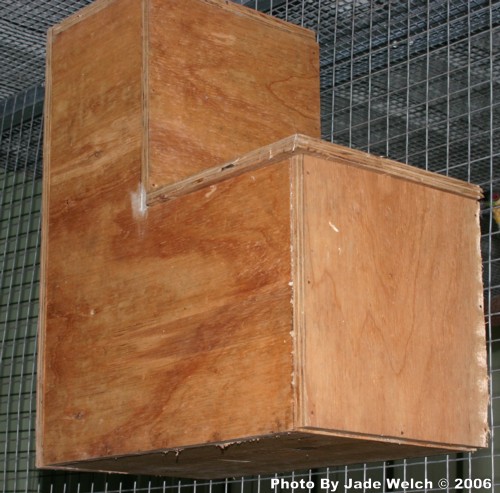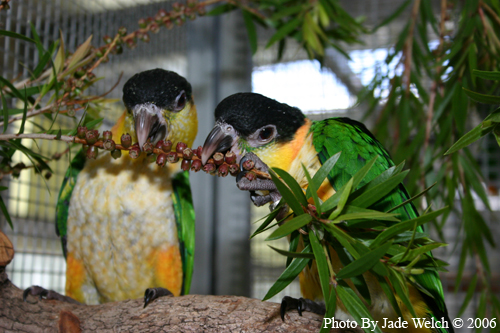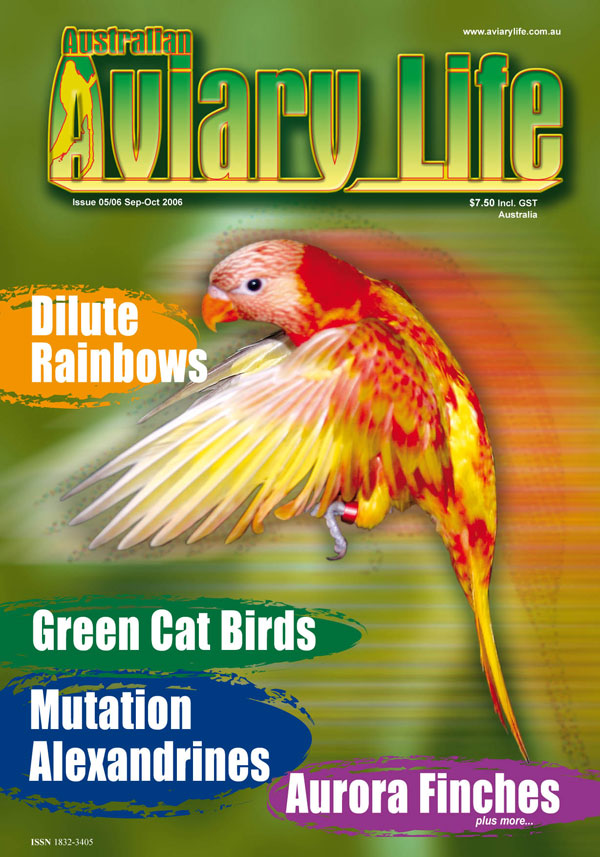The Black-headed Caique
 The Black-headed Caique (Pionites melanocephala) is a comical species that originates from parts of South America and is well known for its distinctive plumage, playfulness and clown like characteristics. It travels in small flocks and family parties and lacks the powerful flight that may be seen in many of the South American Parrot species. A variety of fruits, berries, seeds and even live food form the diet of these birds in the wild.
The Black-headed Caique (Pionites melanocephala) is a comical species that originates from parts of South America and is well known for its distinctive plumage, playfulness and clown like characteristics. It travels in small flocks and family parties and lacks the powerful flight that may be seen in many of the South American Parrot species. A variety of fruits, berries, seeds and even live food form the diet of these birds in the wild.
Housing
Black-headed Caiques are not strong flyers and thus do not require a large aviary. Here at Perky Parrots we keep our Black-headed Caiques in suspended aviaries measuring 4 metres long x 1.2 metres wide x 1.2 metres high. However a conventional aviary of approximately 3 metres long x 2 metres high x 1.2 metres wide is acceptable as is a suspended aviary measuring 3 metres long by 1.2 metres high x 1.2 metres wide. Although not strong flyers a Caique that is given the chance to fly away will do so, so a safety walkway should be installed on the aviary provided.
Only one pair of Black-headed Caiques should be kept per aviary as these birds will fight with other members of their own kind. It is also suggested that no other species be mixed with these birds as again fighting may occur. If you are keeping your Caiques side by side (or next to birds of another species in a row of aviaries) double wiring or a full partition down the middle of the aviary is suggested. At Perky Parrots however we have half of the side towards the back covered in colourbond sheeting and the adjoining front section double wired. This allows the birds privacy and the ability to see their neighbors.
The back half of the roof of the aviary should be covered with a suitable colourbond sheeting like trimdeck and the front half with a suitable wire. This will allow the birds to sun themselves and enjoy rain showers at the front whilst being able to retreat to the back half during inclement weather or at times when birds of prey are about. Only aluminium or steel should be used to construct the aviary these birds are housed in as they are great lovers of wood and will ruin a wooden framed aviary in a matter of weeks.
Our Caique aviaries (see photo included) have a cement rat wall that is sunk into the ground to a depth of 600mm with an extra 200mm above ground adjoined by colourbond sheeting. The colourbond sheeting is 1.2 metres high and prevents rodents and snakes from entering the aviaries. We use quality 12.5mm x 12.5mm 1.6 guage wire. This wire is well suited to house our Amazons, Grey’s, Caiques, Hahn’s Macaws and Conures. 
Each bank of aviaries is also fitted with a sprinkler system and automated water. The sprinkler system is turned on when required and provides the birds with a fine mist to bathe in. The automated watering system however comes on twice a day and is triggered by a computer. Regardless of this all water is checked twice daily.
If you intend on keeping your Black-headed Caique as a pet it is advisable that you purchase a sturdy and spacious cage from your local pet shop. A cage that is longer in length will allow the bird to fly more. Caiques will chew wood and so a wooden cage is not advisable nor is a plastic cage. A cage that is round is also not recommended as birds do not feel at ease in round cages.
A good cage should not be flimsy and be constructed of quality materials, have a good latch for locking the cage, be easy to clean and have appropriate bar spacing so the bird can not stick its head out of the cage. A quality cage should also have a removable tray and grid at the bottom of the cage. The tray acts to collect the bird’s droppings and fallen foods whilst the grid is designed to keep the birds from accessing potentially fouled food and their droppings. A cage should be cleaned every two weeks and the perches should be replaced regularly.
Also essential for the cage are perches and toys. Perches made out of non toxic branches such as those from eucalypts, bottlebrush, acacias or grevillia’s are great for use with both pet and aviary birds. It is wise to wash the perches and allow them to dry before placing them in the cage. When selecting branches to use as perches, you should select them from areas that are free from chemical sprays and that you are permitted to remove branches from. The renewal of chewed or fouled perches should be undertaken regularly.
Caiques are clowns and love to play and for this reason sturdy toys should be provided. These toys can be purchased from pet shops, bird toy suppliers and bird clubs. Before purchasing any toy for a bird it is wise to talk with whom ever it is selling the toy to you to make sure the toy is safe for use with your bird. Incidences where inferior quality toys have killed or maimed birds have been reported and continue to do damage due to poor advice.  Roosting Time
Roosting Time
Caiques love to sleep in a nestbox so if you are keeping your bird/s in an aviary it is advisable to keep a nestbox in the aviary at all times. If however you are keeping your bird as a pet you may choose to keep a nestbox in the cage for the bird to roost in or alternatively you may place a cover over the cage at night. The cage cover should be made of a dark and durable material which will allow the bird/s to breath when it is placed over the cage. Allowing the bird to chew the cover is not advisable as it could have severe if not fatal effects on the bird.
Feeding
Here at Perky Parrots we feed our Caiques a mix of Roudybush pellets, sprouted seed, and fruit and vegetables on a daily basis. The pellets are placed in a separate bowl to the fruits and vegetables which are mixed with the sprouted seed. Each day in the morning the birds receive fresh water and a mix of fruits, vegetables and sprouted seed. In the afternoon the water is changed and pellets are given whilst any uneaten parts of the fruit, vegetable and sprouted seed mixture are removed from the aviary. During the breeding season fruits, vegetables and sprouted seed are provided twice a day to birds with young.
If you wish to feed your birds seed a good quality cockatiel or small parrot seed mix is suggested. Fruits and vegetables which may be fed to these birds include carrot (boiled first and allowed to cool), grape, pear, apple, peas, corn on the cob, orange, star fruit, pumpkin etc. Passionfruit is also a favourite food but may become a problem if fed to often as Caiques love to flick the pulp about. This love of flicking the pulp abouts means that it may stick to anything within site of the cage or aviary that it lands on which may include walls, furniture etc which will require regular cleaning.
Some foods should never be fed to any bird even though they may seem harmless or taste good to us. Avocado and Rhubarb are two such foods which should never be fed as they have may prove fatal to your bird/s. Chocolate, coffee, salt, tea, alcohol, sweets and food scraps are also not recommended. Providing your birds with a calcium bell or cuttlebone is recommended.
Fruits and vegetables should only be kept in the aviary or cage for approximately four to six hours (depending on where you live and the climate in your area) and be kept out of direct sunlight so the fruits and vegetables won’t become spoiled and go sour or begin to ferment. Water should be replaced daily and water bowls should not be kept under perches as the birds may contaminate it with their droppings. Seed should be replaced on a daily basis if need be.
Breeding Time  Black-headed Caiques reach sexual maturity at around two to three years of age. With the onset of the breeding season which in Australian begins around August also comes a change in the behavior of a pair that are ready to breed. The cock becomes aggressive and protective and the hen and cock start to work the box. Physical changes also occur with the vent of the hen in particular swelling to almost double its usual size.
Black-headed Caiques reach sexual maturity at around two to three years of age. With the onset of the breeding season which in Australian begins around August also comes a change in the behavior of a pair that are ready to breed. The cock becomes aggressive and protective and the hen and cock start to work the box. Physical changes also occur with the vent of the hen in particular swelling to almost double its usual size.
A boot or Z style nestbox like that pictured with wooden cleats screwed onto the inside of the box has proven to be sufficient for breeding these birds. The cleats give the hen something to chew whilst she is on the nest incubating or caring for young. A clutch of two to four eggs is considered the norm with incubation taking approximately 25 to 27 days. Caiques generally make good parents and in most cases can be relied (expect exceptions) on to raise their own young which take approximately 70 days (sometimes more) to fledge. Ringing of chicks can be done between the ages of 12 and 13 days with a stainless steel leg ring.
Made for Toys
As mentioned before Caiques love toys and require them for mental stimulation. Toys suitable for Caiques come in many forms some of which include ropes and chains suitable for birds (available from pet shops or bird clubs). Whilst ropes toys and chains can be great play toys they can also pose a risk if your bird gets its toes, beak or any other body part stuck so one must make careful observations regularly (daily if need be) to make sure that the rope or chain is in good working order and that there is no chance the bird could get itself stuck. If in doubt throw it out is the best way to think of it.
The best toys of all though are seed pods (the dried seed pods of a number of eucalyptus species are ideal) and fresh branches (easily grown in ones backyard) of non toxic tree and palm species. Branches which we use regularly to keep these birds entertained come from golden cane palms and bottlebrush's. Both give the birds something which is a little different. The bottlebrush with its smaller leaves, seed pods, flowers and bark are as appealing as the golden cane palm with its long leaves and stem and smooth bark. 
Both the golden cane and bottlebrush are not only ideal in that they allow these birds a chance to clamber and climb about but they also provide the bird/s with something to chew. Both may also be sprayed with a fine mist of water to further stimulate and excite the birds mind. Replacement of any toy/s or branch/es should be undertaken regularly (for pet and aviary birds) as should be the regular rotation of toys. Regularly rotating toys will prevent boredom in these highly energetic and enquisitive birds.
Pops and Whistles
Caiques are not renowned for their talking skills seeming to lack the ability to learn and pronounce a wide range of words. They do however have the ability to learn a number of pops and whistles. This however should not deter the potential Caique owner as the exuberance, playfulness and strong character of these birds should be rewarding enough.
Bathing
Black-headed Caiques love to bathe and so a large shallow bowl filled with water may be placed in the bird/s cage or aviary. Take care however that if you are doing this that you have put the cage in a place where items around it are not of great value such as paper work as these birds will flick their water everywhere. Branches of non toxic trees or plants may also be given to the birds when wet as they love to crawl about the wet foliage. Watching a Caique bathe can be quite comical at times.
Household Hazards
Caiques by nature are inquisitive birds and will find any trouble in sight. Beware that many dangers exist in each household and that prevention is better then cure. Some of these dangers include poisonous plants, exposed electrical leads and wires, windows, water sources and Teflon cookware. Of course a number of other dangers may exist but those previously mentioned are amongst the most common.
Teflon cookware when heated can give off fumes that are poisonous to birds so it is recommended that you keep your birds well away from any area where you are using Teflon cookware. Failing to do this can result in the death of your bird/s. Glass windows pose a serious threat to both wild and pet birds which rarely notice them. It is for this reason that windows should be covered with blinds or curtains to prevent your bird/s from hitting them. Window strikes can prove to be fatal in some situations.
Commonly grown plants can also be poisonous, as can fertilizers and potting mixes so it is advisable that you keep all plants, fertilizers and potting mixes out of reach of your birds. Of course the washed branches of non toxic plants can be given to your bird/s to keep boredom at bay. If you are in doubt about whether or not a plant is poisonous or not then refrain from using it.
Exposed leads and wires are also a potential danger and should be kept well hidden to prevent your bird/s from chewing them. Caiques are not good swimmers and will find themselves in danger if they happen to land or fall into a large water source such as a kitchen sink filled with water, a toilet bowl or a fish tank. For this reason it is recommended that you keep your water sources covered or the birds well away from them. Keeping an eye on your bird/s at all times is highly recommended to avoid possible heartbreak.
Books on Caiques
Looking for a good book on Caiques? Why not visit our Rec Reading page to read up on Rosemary Low's fantastic book CAIQUES which is available from ABK Publications.
Suggested Books and Articles  Black-headed Caiques “Colourful Clowns” By Shane Handcock featured in the Sep-Oct 2006 of Australian Aviary Life Magazine
Black-headed Caiques “Colourful Clowns” By Shane Handcock featured in the Sep-Oct 2006 of Australian Aviary Life Magazine .jpg?1366670814) Caiques by Rosemary Low published by Dona Publications
Caiques by Rosemary Low published by Dona Publications  The Black-headed Caique By Jade Welch featured in the Jan-Feb 2006 edition of Australian Aviary Life Magazine
The Black-headed Caique By Jade Welch featured in the Jan-Feb 2006 edition of Australian Aviary Life Magazine
Disclaimer: To the best of our knowledge everything on this website is correct, however we do not take any responsibility for incorrect information. Like everything else on the internet, use with caution.
